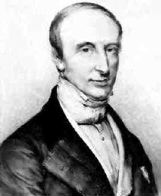

Augustin Louis Cauchy's father was active in his education. Laplace and Lagrange were visitors at the Cauchy family home, and Lagrange in particular seems to have taken an interest in young Cauchy's mathematical education. Lagrange advised Cauchy's father that
his son should obtain a good grounding in languages before starting a serious study of mathematics, so he spent two years studying classical languages.
From 1804 Cauchy attended classes in mathematics and he took the entrance examination for the Ecole Polytechnique in 1805. He was examined by Biot
and placed second. At the Ecole Polytechnique he attended courses by Lacroix, de Prony and Hachette while his analysis tutor was Ampère. In 1807 he
graduated and entered an engineering school. He was an outstanding student there.
In 1810 Cauchy took up his first job in Cherbourg to work on port facilities for Napoleon's English invasion fleet. In addition to his heavy workload Cauchy undertook mathematical researches, and he proved in 1811 that the angles of a convex polyhedron are
determined by its faces. He submitted his first paper on this topic then, encouraged by Legendre and Malus, he submitted a further paper on polygons and
polyhedra in 1812. Cauchy felt that he had to return to Paris if he was to make an impression with mathematical research.
An academic career was what Cauchy wanted and he applied for many posts. He did not succeed, being beat by the likes of Legendre, Poinsot, Ampère, and Binet.
Despite this, his mathematical output remained strong. In 1814 he published the memoir on definite integrals that later became the basis of his theory of complex functions. In 1815, he investigated symmetric functions and published a memoir on this topic.
In 1815, he was appointed assistant professor of analysis at the Ecole Polytechnique. In 1816 he won the Grand Prix of the French Academy of Science for a work on waves. He achieved real fame however when he submitted a paper to the Institute solving one of Fermat's claims on polygonal numbers made to Mersenne. Politics now helped Cauchy
into the Academy of Sciences when Carnot and Monge fell from political favour and were dismissed and Cauchy filled one of the two places.
He began to teach at the Collège de France. There he lectured on
methods of integration which he had discovered earlier. Cauchy was the first to make a rigorous study of the conditions for
convergence of infinite series in addition to his rigorous definition of an integral. His text was designed for students at Ecole
Polytechnique and was concerned with developing the basic theorems of the calculus as rigorously as possible. He published a study of the calculus of
residues in 1826, and in a 1829 paper he defined for
the first time a complex function of a complex variable.
By 1830, the political events in Paris and the years of hard work had taken their toll and Cauchy decided to take a break. He spent a short time in Switzerland.
Political events in France meant that Cauchy was now required to swear an oath of allegiance to the new regime, and when he failed to return to Paris to do
so he lost all his positions there. He taught in Turin in 1832, and in Prague the following year.
Cauchy returned to Paris in 1838.
During this period Cauchy's mathematical output was less than in the period before his self-imposed exile. He did important work on differential
equations and applications to mathematical physics. He also wrote on mathematical astronomy. The 4 volume text he published between 1840 and 1847 proved extremely important.
When Louis Philippe was overthrown in 1848, Cauchy regained his university positions.
Numerous terms in mathematics bear Cauchy's name: the Cauchy integral theorem, in the theory of complex functions, the Cauchy-Kovalevskaya existence theorem for the solution of partial differential equations, the Cauchy-Riemann equations, the Cauchy distribution in probability, and Cauchy sequences. He produced 789 mathematics papers, an incredible achievement.